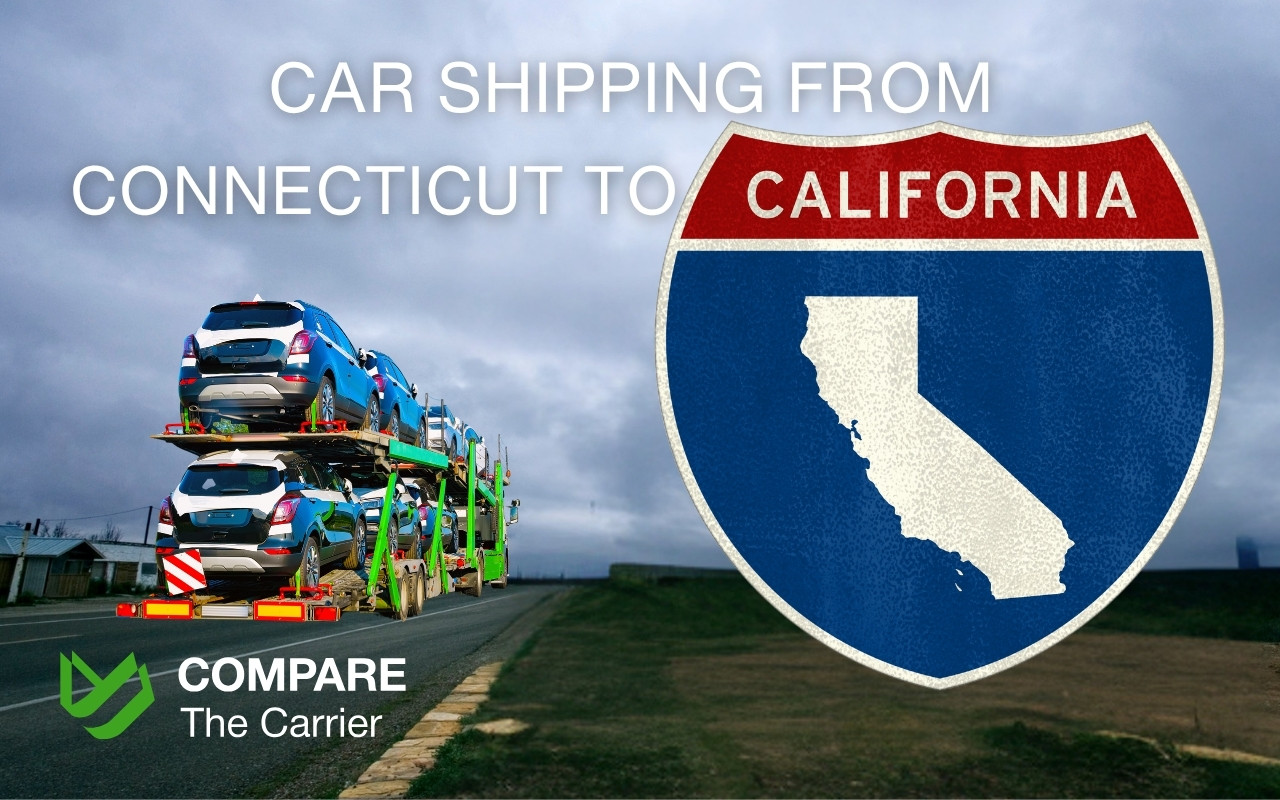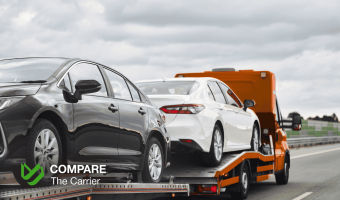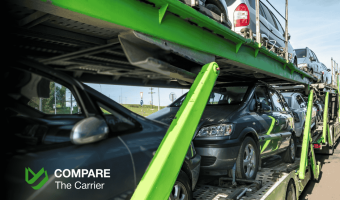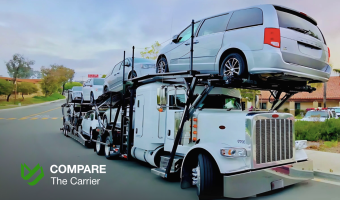Why Ship a Car from Connecticut to California?
As of early 2025, California continues to be a top destination for transplants, with over 280,000 people moving into the state annually — many from the East Coast. Connecticut, in particular, has seen a noticeable outflow, with residents relocating for better weather, career changes, or retirement opportunities. But driving your car over 2,900 miles from CT to CA isn’t just time-consuming — it can be risky and expensive.
According to AAA’s national gas price tracker, fuel in May 2025 averages $4.42 per gallon in California — up nearly 7% year-over-year. Add to that the cost of hotels, food, and vehicle wear-and-tear across multiple states, and the value of professional auto transport from Connecticut to California becomes obvious.
Whether you’re a student heading to UCLA, a family relocating to San Diego, or a car enthusiast moving a vintage Porsche to the Bay Area, cross-country car shipping from Connecticut to California offers a cost-effective, safe, and convenient alternative to a long-haul drive. It also spares your vehicle thousands of unnecessary miles and exposure to unpredictable conditions on I-80 or I-70.
But not all transport experiences are created equal. Scams, hidden fees, and poor communication are unfortunately common in the industry. That’s why CompareTheCarrier.com was built — to give customers a simple, transparent way to find trusted auto transporters who are licensed, insured, and highly rated.
In this complete guide, you’ll learn:
- How to plan and book your Connecticut to California vehicle transport
- What influences your shipping cost
- How to prep your car for the journey
Why using a quote comparison tool like CompareTheCarrier can save you time, money, and stress.
How Auto Transport Works from Connecticut to California
Shipping a car from Connecticut to California might sound complicated, but when broken down step by step, it’s a highly manageable process — especially when working with a trusted auto transporter. Whether you’re shipping a daily driver, a family minivan, or a high-end luxury vehicle, the basic structure of auto transport from Connecticut to California follows a reliable and proven framework.
Here’s what the process looks like from start to finish.
Step 1: Get Quotes from Verified Carriers
Your first step is to gather and compare shipping quotes. Rather than calling carriers one by one, use a platform like CompareTheCarrier.com to receive multiple quotes from FMCSA-licensed and insured companies with five-star reviews. This helps ensure:
- You’re only choosing from top-rated auto shipping providers
- There are no hidden fees
- You get a fair market price, not inflated or too-good-to-be-true numbers
Quick Tip: Be sure to have details like your pickup and delivery ZIP codes, vehicle type, transport method (open/enclosed), and desired pickup window ready for the most accurate quote.
Step 2: Book Your Shipment and Confirm the Details
Once you select the carrier or broker that best fits your needs, you’ll confirm:
- Pickup and drop-off addresses
- Estimated pickup and delivery dates
- Type of trailer (open or enclosed)
- Insurance coverage and any optional services
The carrier will send you a confirmation contract with all the details spelled out, including your rights, cancellation terms, and payment process.
Step 3: Carrier Assignment and Pre-Pickup Communication
If you’re using a broker, they’ll assign your shipment to a qualified carrier within their vetted network. The carrier will contact you 12–48 hours before pickup to:
- Confirm logistics and access details
- Provide the driver’s name and contact number
- Coordinate any unique delivery challenges (e.g., limited-access streets in West Hartford or narrow roads near Stamford)
Step 4: Vehicle Inspection and Pickup
The driver arrives, inspects your vehicle, and fills out the Bill of Lading (BOL) — a critical legal document that includes:
- The condition of your car at pickup
- Any pre-existing damage
- Vehicle mileage and identifying details
You’ll review and sign the BOL, and the vehicle is then loaded onto the transport truck.
Pro Tip: Take your own timestamped photos of your car from every angle before it’s loaded. This provides extra insurance in the rare case of damage during Connecticut to California vehicle transport.
Step 5: Cross-Country Transit — CT to CA
Your car travels approximately 2,900 to 3,100 miles, depending on the exact route. Most California car delivery from Connecticut takes 7 to 10 days, though this varies based on:
- Distance and route
- Weather and road conditions
- Number of stops the carrier makes
Some top-rated auto shipping companies offer GPS tracking or regular status updates, especially for enclosed transport or high-end vehicles.
Step 6: Delivery and Final Inspection in California
Once your car arrives in California, the driver will perform a final inspection to ensure it matches the condition noted on the BOL. You (or your designated recipient) should:
- Inspect the car thoroughly
- Note any damage
- Sign the final paperwork only when everything checks out
If there’s a balance due, payment is typically made at this time (unless you prepaid in full).
By following these steps and working with a platform that vets every carrier, cross-country car shipping from Connecticut to California becomes a straightforward and secure process.
Broker vs Carrier: What’s Better for Connecticut to California Shipping?
One of the most important decisions you’ll make during the auto transport from Connecticut to California process is whether to go through a broker or work directly with a carrier. Both options can get your vehicle from CT to CA, but the experience, flexibility, and pricing can vary dramatically based on the path you choose.
Here’s what you need to know to make the right choice.
What is a Carrier?
A carrier is the company that physically ships your vehicle. They own the transport trucks, employ the drivers, and handle the hands-on logistics of pickup, hauling, and delivery.
Pros:
- Direct relationship with the hauler
- Potentially lower cost (no middleman fees)
- More control over communication with the driver
Cons:
- Limited availability, especially on long-haul routes like Connecticut to California
- You must vet licensing, insurance, and reputation on your own
- Few options for comparing rates unless you contact multiple carriers individually
Example: If you live in New Haven and want to ship a car to San Diego, finding a direct carrier with availability that week may be difficult — unless you’re flexible on timing or willing to pay more.
What is a Broker?
A broker acts as an intermediary between you and a network of vetted carriers. They don’t own trucks, but they handle:
- Rate negotiation
- Carrier selection
- Scheduling and customer support
Platforms like CompareTheCarrier.com are modern brokers, giving users access to real-time pricing, carrier ratings, and verified FMCSA data, all in one place.
Pros:
- Access to a larger network = faster pickup times
- Transparent pricing from multiple top-rated auto shipping companies
- Brokers handle all the paperwork and coordination
- Ideal for long-distance or first-time shippers
Cons:
- You don’t choose the driver directly (though you’ll be notified in advance)
- Some brokers (not CompareTheCarrier) may prioritize price over service quality
Broker vs Carrier: Which Is Better for CT to CA?
| Feature | Carrier | Broker via CompareTheCarrier |
| Availability | Limited | Wide network, nationwide coverage |
| Pricing Transparency | Depends on individual quotes | Multiple quotes side by side |
| Customer Support | Varies by company | Expert support team included |
| Ideal For | Simple, local shipments | Long-distance, complex, or first-time shippers |
| Licensing/Vetting | You must do it yourself | Done for you |
When a Broker Makes More Sense
If you’re dealing with:
- A cross-country move
- A tight relocation timeline
- A specialty vehicle (luxury, classic, etc.)
- Or you simply want the most reliable, hands-off experience
Then working with a broker — especially a trusted platform like CompareTheCarrier — is almost always the better route.
Real Example: “We needed to ship our daughter’s car from Greenwich to Santa Clara for college. Compare The Carrier found us three options in 15 minutes, and the whole thing went off without a hitch.” — Lillian M., Verified Customer.
Car Shipping Cost from Connecticut to California
Understanding the Connecticut to California car shipping cost is essential for planning your move or vehicle delivery. Prices can vary widely depending on multiple factors — some of which are within your control. In this section, we’ll break down typical price ranges, what’s included, and how to ensure you get the most value without sacrificing service quality.
Average Cost to Ship a Car from Connecticut to California
As of 2025, the average cost to ship a car from Connecticut to California ranges between $1,200 and $1,700 for standard open carrier service. The exact price depends on the pickup/drop-off locations, vehicle type, and service preferences.
| Transport Type | Estimated Price Range | Transit Time |
| Open Carrier (Standard) | $1,200 – $1,600 | 7–10 days |
| Enclosed Carrier | $1,600 – $2,200+ | 7–10 days |
| Expedited Delivery | $1,800 – $2,500+ | 3–5 days |
These estimates are based on typical shipments from cities like Hartford, Stamford, and New Haven to major California destinations like Los Angeles, San Diego, San Francisco, and Sacramento.
What’s Included in the Price?
A standard quote from a top-rated auto shipping company will usually include:
- Door-to-door pickup and delivery
- Basic liability and cargo insurance
- Fuel costs, tolls, and labor fees
- Standard pickup window (typically 1–5 days from booking)
Important: Not all quotes are created equal. Lowball quotes may hide additional fees or use unverified carriers. Always confirm what’s included.
Real Customer Example
“I shipped my 2020 Hyundai Tucson from Bridgeport to Los Angeles in February. CompareTheCarrier gave me four quotes — I went with a 4.9-star rated carrier and paid $1,350. The car arrived in 8 days in perfect condition.” — Jason P., Verified Review
Optional Costs That May Apply
Be aware of common surcharges that can affect your Connecticut to California vehicle transport bill:
- Non-operational vehicle: $100–$200 extra
- Oversized SUV or pickup: $150–$300 extra
- Enclosed transport: 30–50% more than open carrier
- Remote pickup/delivery: Slight increase for hard-to-access or rural locations
- Expedited service: May add $400–$800 depending on urgency
Want to avoid surprises? Always request a full breakdown of any potential additional fees before booking.
How to Get the Best Price
- Compare multiple quotes — Use CompareTheCarrier to instantly receive pricing from rated, reliable providers.
- Book early — Last-minute bookings can cost 10–20% more.
- Be flexible on pickup/delivery dates — Flexibility = lower rates.
Avoid peak seasons — Rates rise during winter snowbird season (Dec–March) and peak summer months (June–August).

Key Factors That Influence the Cost of Shipping from Connecticut to California
If you’ve ever wondered why one quote for car shipping from Connecticut to California comes in at $1,200 while another hits $1,900, you’re not alone. Understanding the cost drivers behind vehicle transport can help you make smarter decisions, negotiate more confidently, and avoid overpaying.
Here are the main factors that impact the Connecticut to California car shipping cost — and what you can do about them.
1. Type of Transport: Open vs. Enclosed
This is the #1 factor affecting your shipping rate.
- Open transport: The most common and affordable method. Your vehicle is shipped on an open-air carrier with up to 10 others.
- Enclosed transport: Offers full protection from weather and road debris. It’s ideal for luxury, classic, or exotic cars — but costs 30–50% more.
Example: Shipping a Honda Accord via open carrier from Hartford to LA may cost ~$1,350. Using enclosed transport for a Porsche on the same route could cost $1,900+.
2. Vehicle Size, Weight, and Condition
Carriers price based on the space and weight your car occupies on the trailer.
| Vehicle Type | Cost Impact |
| Compact/Sedan | Base price |
| SUV/Truck | +$100 to $300 |
| Oversized Vehicle | May require special handling |
| Inoperable Vehicle | +$100 to $200 (for winching) |
Pro Tip: Always disclose your vehicle’s exact dimensions and condition upfront to avoid surcharges.
3. Pickup and Drop-Off Locations
Shipping from or to urban hubs like Stamford, Bridgeport, or New Haven is cheaper than rural or remote locations. That’s because:
- Carriers frequent metro areas more often
- Rural deliveries may require detours, fuel surcharges, or transfers
Terminal-to-terminal shipping can save money, but door-to-door is more convenient and preferred by most users.
4. Time of Year / Seasonal Demand
Just like airline tickets, transport rates rise and fall with demand:
- Winter (Dec–March): Higher rates due to snowbird moves and poor weather
- Summer (June–August): Peak relocation season = more demand, fewer discounts
- Spring/Fall: Generally more affordable and flexible
FMCSA data shows transport volumes from the Northeast to California spike up to 30% during December, making early booking essential.
5. Expedited vs. Standard Shipping
Need your car delivered ASAP? Expect to pay more for expedited shipping, which prioritizes your vehicle and minimizes wait times.
| Shipping Type | Delivery Window | Price Impact |
| Standard Shipping | 7–10 days | Base rate |
| Expedited Shipping | 3–5 days | +$300 to $800 |
Best for: Job relocations, military orders, last-minute moves
6. Fuel Prices and Route Efficiency
Fuel costs are a big part of any quote. With diesel averaging $4.20/gal nationwide in 2025 (source: AAA Fuel Gauge), carriers factor in:
- Fuel surcharges
- Road tolls and route mileage
- Traffic delays along major corridors like I-95, I-80, and I-70
7. Insurance and Extra Services
Basic insurance is included, but higher-value vehicles may require more comprehensive coverage:
- Confirm policy limits (usually $250,000–$1 million)
- Ask if a deductible applies
- Consider supplemental insurance for peace of mind
Also, premium services like top-load placement, white-glove handling, or real-time GPS tracking can add to your quote — but may be worth it for certain customers.

Step-by-Step Guide to Getting Your Car Ready for Cross-Country Shipping
Once you’ve booked your car shipping from Connecticut to California, it’s time to prepare your vehicle for its journey. Proper prep doesn’t just protect your car — it also ensures smoother pickup, prevents disputes, and keeps the transport timeline on track. Whether you’re shipping a standard sedan or a collector’s car, follow these expert-recommended steps for safe and stress-free vehicle transport from CT to CA.
Step 1: Wash and Inspect Your Vehicle
Start with a thorough exterior and interior cleaning. A clean car makes it easier to identify — and document — any pre-existing scratches, dents, or damage before loading.
- Wash the vehicle thoroughly, including wheels and undercarriage
- Take time-stamped photos from all sides (including the roof, bumpers, and close-ups of any imperfections)
- Note the mileage on the odometer
- Photograph the interior if you’re leaving anything inside (though it’s not recommended)
These records provide crucial evidence in the rare event you need to file an insurance claim post-delivery.
Step 2: Remove All Personal Items
Most carriers and insurance policies do not cover personal belongings left in the car. Items can shift, get stolen, or cause damage during transport.
Remove the following:
- GPS devices, chargers, and electronics
- Documents and valuables
- Garage door openers and toll passes (e.g., EZ-Pass)
- Tools, loose change, bags, or sports gear
Some trusted auto transporters may allow up to 100 lbs of items in the trunk, but you must disclose it in advance — and it’s carried at your own risk.
Step 3: Perform Basic Maintenance
Although your car won’t be driven more than a few hundred feet on and off the trailer, it needs to be operable and safe.
- Top off fluids (oil, coolant, brake)
- Check tire pressure and battery charge
- Make sure there are no leaks
- Secure or remove loose exterior parts (e.g., spoilers, antennae, bike racks)
- Turn off your car alarm
Non-running vehicles require special handling equipment and usually cost more to ship. Be upfront about your car’s condition to avoid delays or rebooking.
Step 4: Leave Only 1/4 Tank of Fuel
More gas means more weight — and a higher risk of leaks. Your transporter only needs enough to load, unload, and move your vehicle if necessary.
- Aim for no more than 1/4 tank of gas
- Empty the tank if you’re shipping a vehicle that’s going into long-term storage or dealership inventory
Step 5: Prepare Keys and Paperwork
Your driver will need one full set of keys, including:
- Ignition or key fob
- Trunk and glovebox (if separate)
- Wheel lock key, if applicable
You’ll also need:
- A printed or digital copy of your shipping contract
- Your Bill of Lading (BOL), which you’ll sign at both pickup and delivery
- A government-issued ID (some carriers may request to verify ownership)
Step 6: Coordinate Access for Pickup
Let the carrier know about:
- Gated communities (provide codes)
- Narrow streets or steep driveways (may require meeting nearby)
- Specific time windows if you or a representative must be present
Real Example: “We lived on a cul-de-sac in Greenwich. The driver called 30 minutes out and we met him in the local library parking lot. Easy.” — Hannah T., Connecticut to California shipment
Bonus: Appoint a Representative if You Can’t Be There
If you’re unavailable at pickup or delivery, assign a responsible adult to:
- Sign the paperwork
- Inspect the car
- Handle final payment (if required)
Notify the carrier in advance and ensure your rep has the proper documents and contact info.
Choosing Between Open or Enclosed Car Transport for a Connecticut to California Move
When organizing car shipping from Connecticut to California, one of the most important decisions you’ll make is choosing between open or enclosed transport. This choice not only affects your total cost but also the level of protection your vehicle receives during the cross-country journey.
Let’s break down the differences so you can confidently choose the method that best suits your needs.
Open Car Transport — The Standard, Affordable Option
Open transport is by far the most commonly used method. Vehicles are loaded onto open, multi-level trailers (the same type used to deliver new cars to dealerships). It’s efficient, cost-effective, and widely available.
Best for:
- Daily drivers, sedans, SUVs, and standard vehicles
- Budget-conscious customers
- Flexible delivery windows
Pros:
- Most affordable option — often 30–40% less than enclosed transport
- Greater carrier availability, especially for cross-country car shipping Connecticut to California
- Faster scheduling and pickup times
Cons:
- Vehicle is exposed to weather, road debris, and dust
- Not ideal for antique, luxury, or high-value vehicles
Example: “I shipped my 2019 Toyota Corolla from Stamford to Los Angeles using open transport. It took 8 days and cost me $1,280. No damage, super easy.” — Michelle R., Verified Customer
Enclosed Car Transport — Maximum Protection for High-Value Vehicles
Enclosed transport places your car inside a fully covered trailer, protecting it from all external elements. These trailers typically haul 2–5 vehicles and are often used for high-end, classic, or rare cars.
Best for:
- Classic or vintage cars
- Luxury or exotic vehicles
- Owners seeking the highest level of protection
Pros:
- Full coverage from weather, road grime, and potential hazards
- Typically includes higher insurance coverage
- Drivers are often trained in handling specialty vehicles
Cons:
- More expensive — typically adds $400–$800+ to your shipping cost
- Fewer available carriers = potentially longer wait times
Case Study: “I had a restored ’67 Mustang shipped from West Hartford to San Diego. Went with enclosed transport for peace of mind — paid $1,950, and the car arrived spotless.” — Chris L., Collector
Which Option is Right for You?
| Criteria | Choose Open Transport | Choose Enclosed Transport |
| Vehicle Type | Standard cars, daily drivers | Classics, exotics, luxury, or high-value cars |
| Budget | Looking for the lowest cost | Willing to pay more for extra protection |
| Protection Needed | Basic, weather-tolerant | Full protection from rain, hail, dust, and debris |
| Insurance Requirements | Standard coverage is sufficient | Need higher policy limits and zero-deductible options |
| Timing and Availability | Flexible scheduling and faster pickups | May wait longer for a slot |
Still not sure? With CompareTheCarrier.com, you can request and compare both open and enclosed shipping quotes side-by-side — helping you make an informed choice without any pressure.

What to Expect on Delivery Day in California
Your vehicle has successfully made the journey from Connecticut to California — now it’s time for the final step: delivery. Whether it’s arriving in Los Angeles, San Francisco, San Diego, or a smaller California city, knowing what to expect on delivery day ensures a smooth handoff and helps you avoid last-minute surprises or delays.
Here’s exactly how California car delivery from Connecticut plays out — and how to prepare.
1. Advance Call from the Driver
Most professional carriers will reach out 24 hours before delivery to:
- Confirm the drop-off address and time window
- Discuss any accessibility issues (tight streets, HOA rules, steep driveways)
- Coordinate a nearby meeting point if your address isn’t truck-friendly
Pro Tip: Stay available by phone and make sure someone 18+ is present to receive the car.
2. Delivery Location Logistics
Large transport trucks can’t always access residential streets in dense or hilly areas — common in places like San Francisco, Santa Barbara, or parts of Orange County. If needed, the carrier will arrange to meet you at:
- A public parking lot
- A nearby shopping center
- A wide street with ample space to unload
Real Example: “Our neighborhood in Burbank had tight corners, so the driver met us at a Target parking lot two blocks away. Quick and easy.” — Jordan A., Connecticut to California shipment
3. Vehicle Inspection and Bill of Lading
This step is critical. Before you sign off, you’ll complete a final inspection with the driver.
- Compare your car’s current condition to the Bill of Lading (BOL) from pickup
- Look for any new damage — scratches, dents, or mechanical issues
- Note anything unusual directly on the BOL before signing
Be sure to:
- Walk around the car slowly and inspect in daylight if possible
- Check the odometer reading
- Take photos of the vehicle at delivery for your records
Important: If you find damage not listed at pickup, document it, notify the carrier, and start the insurance claim process. Don’t delay — your signed BOL is key to any reimbursement.
4. Final Payment (If Applicable)
Depending on your payment arrangement:
- You may have paid in full at booking
- Or you may owe a balance at delivery, often paid via:
- Cash
- Certified check
- Zelle or Venmo (varies by carrier)
- Cash
Reminder: Get a receipt or proof of final payment for your records.
5. Quick Operational Check
Before driving away, do a fast function check:
- Start the engine and listen for unusual noises
- Check fluid levels if it’s been over a week in transit
- Make sure tires are properly inflated
- Verify brakes, lights, and battery
Reinstall any items removed before shipping (toll tags, car seats, etc.).
6. What If You Can’t Be There?
You can assign a designated representative to accept delivery. Just be sure to:
- Notify the carrier ahead of time
- Provide your rep with the Bill of Lading and photo documentation
Ensure they have your contact info and know what to inspect, or emotionally irreplaceable, enclosed shipping is worth the investment for peace of mind.
Conclusion
With thousands of transport companies out there, choosing the right one to handle your auto transport from Connecticut to California can feel overwhelming. That’s exactly why CompareTheCarrier.com was created — to simplify the search, remove the risk, and connect you with licensed, professional, and affordable transporters you can trust.
Here’s how Compare The Carrier puts you in the driver’s seat — even when someone else is behind the wheel.
1. Access to FMCSA-Licensed, Vetted Carriers
Every transporter on CompareTheCarrier is:
- Fully licensed by the Federal Motor Carrier Safety Administration (FMCSA)
- Insured and compliant with industry standards
- Screened for customer satisfaction, on-time delivery, and safety ratings
That means no fly-by-night operators. No guessing games. Just trusted auto transporters with five-star reviews and a proven track record.
According to the FMCSA, over 1,000 consumer complaints are filed each year related to unauthorized transporters. CompareTheCarrier ensures you’re never at risk.
2. Transparent, Real-Time Quotes
Compare The Carrier provides instant access to:
- Competitive quotes from multiple top-rated auto shipping companies
- Clear pricing that includes all fees, fuel costs, and basic insurance
- Side-by-side comparisons of services, delivery speed, and customer reviews
You’ll never be hit with a surprise fee or pressured into accepting a quote that doesn’t fit your needs.
3. Designed for Every Type of Shipper
Whether you’re:
- A snowbird relocating seasonally
- A student heading to a California campus
- A car enthusiast moving a collector vehicle
- A family or dealer handling multiple cars…
Compare The Carrier has a solution tailored for you, backed by a network of transporters that know how to handle your unique shipping needs — fast, safe, and efficiently.
4. Real, Human Customer Support
Questions about enclosed transport? Need help prepping your vehicle? Wondering how soon you can get your pickup scheduled?
Our U.S.-based support team is made up of real experts — not bots or outsourced reps. We’re here to help before, during, and after your shipment.
“I had a last-minute change to my pickup window and the CompareTheCarrier team got it sorted in 10 minutes. Great service!” — Evelyn K., Hartford to Los Angeles move
5. Safer Shipping, Fewer Surprises
CompareTheCarrier users benefit from:
- Verified carrier insurance policies
- Comprehensive service descriptions
- Accurate delivery windows
- Trusted reviews from real people who’ve shipped from CT to CA
This all adds up to fewer delays, fewer claims, and a smoother shipping experience.
A Smarter Way to Ship from Connecticut to California
From your first quote to final delivery, Compare The Carrier is built to take the guesswork out of vehicle shipping. It’s the only platform that brings together transparency, customer service, technology, and industry expertise — all in one place.
So whether you’re shipping your daughter’s car to college in Santa Barbara or relocating your family’s SUV to San Diego, Compare The Carrier helps you do it right — and save money while you’re at it.
Ready to start? Request your free quote today and compare your options from reliable, rated carriers in under 60 seconds.
We ensure safe, cost-effective transport, and connect you with real, rated, and connect you with regulated experts who deliver on their promises.
FAQ
Still have questions about shipping your vehicle from Connecticut to California? We’ve compiled the most frequently asked — and most important — answers to help you feel fully informed and confident before booking your transport.
How long does it take to ship a car from Connecticut to California?
Standard delivery takes between 7 to 10 days, depending on the route, carrier schedule, and any delays due to weather or traffic.
Expedited shipping is available and typically shortens delivery to 3–5 days, but costs more.
Most carriers provide a 1–4 day pickup window after booking.
Tip: Booking early gives you more control over timing and better rates.
What is the average cost to ship a car from CT to CA?
The average Connecticut to California car shipping cost ranges from:
$1,200 to $1,600 for standard open transport
$1,600 to $2,200+ for enclosed transport
$1,800+ for expedited or premium services
Exact pricing depends on vehicle size, location, service type, and time of year.
Is my car insured during transport?
Yes. All carriers listed on CompareTheCarrier are FMCSA-licensed and insured.
Basic insurance is included in the shipping cost (usually covers up to $250,000–$1M).
Coverage applies to damage caused during loading, transport, or unloading.
Personal items left inside the vehicle are not covered.
Always review the carrier’s insurance terms before shipping — and consider supplemental insurance for luxury or classic cars.
Should I choose open or enclosed car transport?
Open transport is best for standard vehicles and offers the lowest price.
Enclosed transport is ideal for high-value, exotic, or classic cars needing protection from weather and road debris.
If your vehicle’s value is over $50,000 or it holds significant sentimental value, enclosed is highly recommended.
Can I put personal items in my car during shipping?
It’s not recommended. Most carriers prohibit personal items for safety and insurance reasons.
Some allow up to 100 lbs in the trunk — at your own risk.
Items must be declared in advance and cannot obstruct driver visibility or access.
Never leave:
Electronics
Documents
Valuables
Tools or loose items
Do I need to be present when the car is picked up or delivered?
Yes, or you’ll need to assign a designated representative who is 18+.
That person will:
Sign the Bill of Lading
Inspect the vehicle with the driver
Handle any final payments or paperwork
Let the carrier know in advance if someone else will be present.
What is the Bill of Lading and why is it important?
The Bill of Lading (BOL) is a legal document that:
Confirms the condition of the vehicle at pickup and delivery
Details the agreed-upon terms between you and the transporter
Serves as your primary proof for any damage claims
Always inspect your vehicle thoroughly and do not sign the BOL at delivery until you’ve confirmed everything is in order.
Can I ship a car that doesn’t run?
Yes, but it must be disclosed at booking. Inoperable vehicles require special loading equipment and will cost more to transport.
Additional fee: Typically $100–$200 depending on the carrier and trailer type.
















